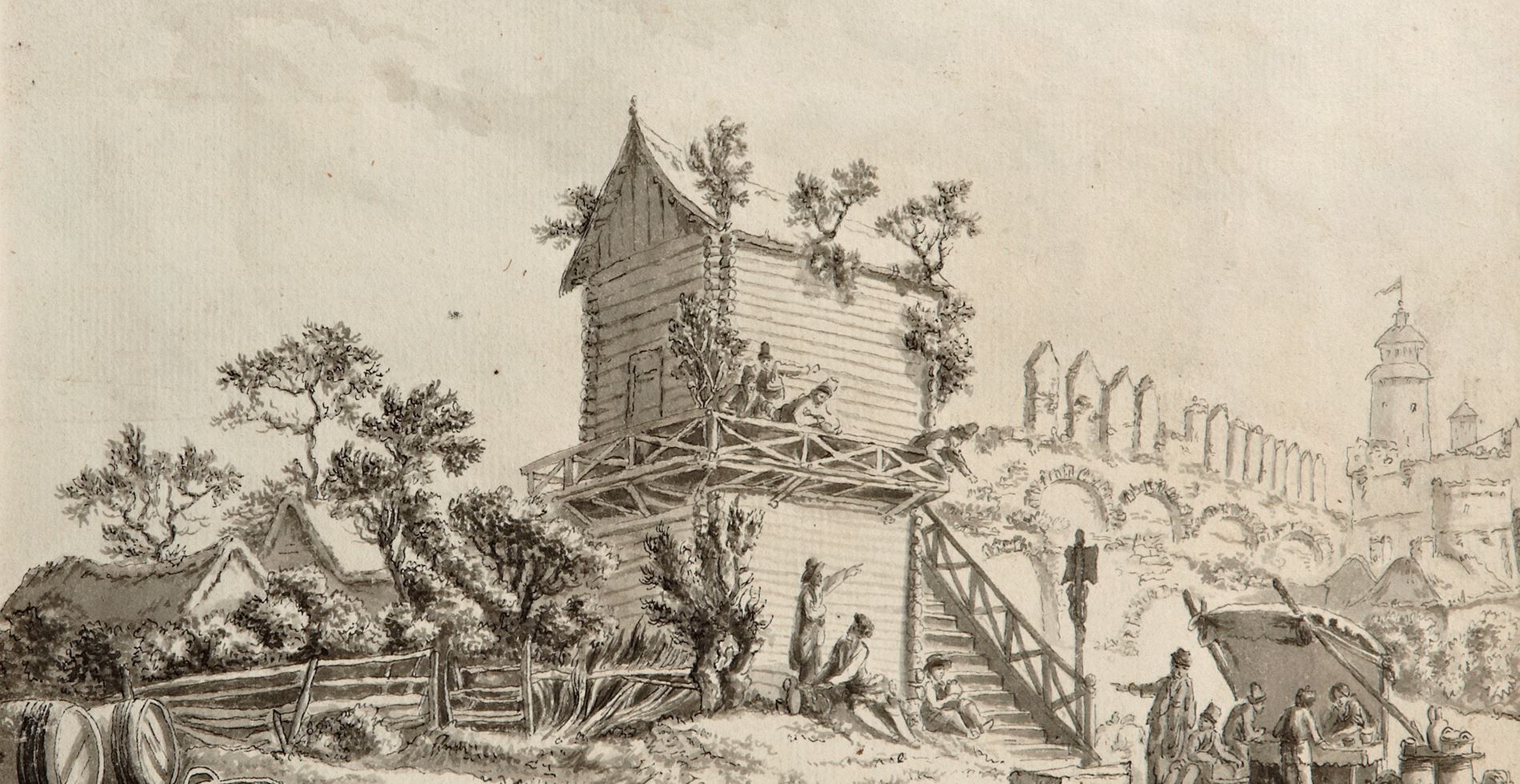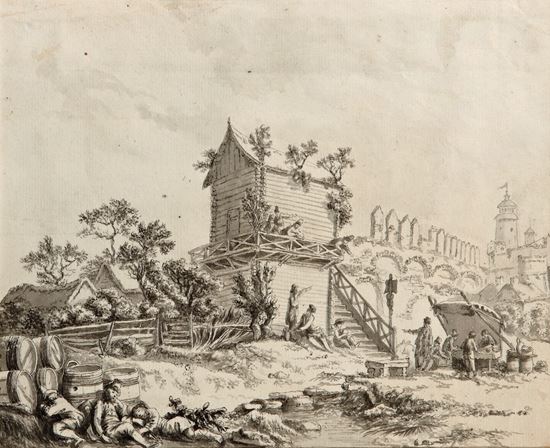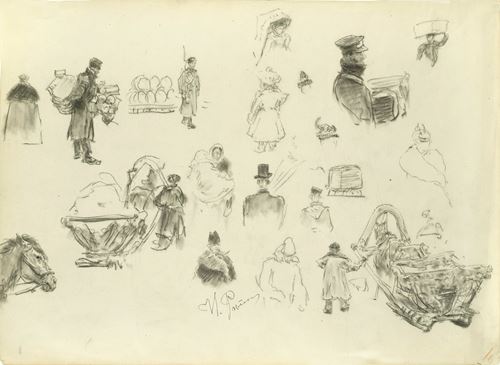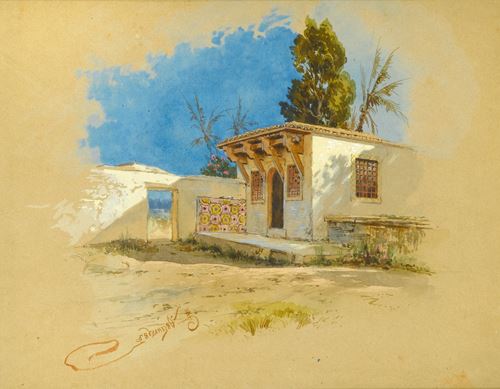ean-Baptiste Le Prince
(Metz 1734 - Saint-Denis-du-Port 1781)
Le Cabaret de Moskou
pen and black ink with gray wash on paper
19 x 23.5 cm (7½ x 9¼ in)
In this important work by Jean-Baptiste Le Prince, we see a variety of figures outside a tavern on the outskirts of Moscow. On the left-hand side three intoxicated figures sit or lie in the mud by some discarded barrels. On the other side of the work, figures crowd around a stall trying to buy refreshments, whilst others relax in the sunshine. These figures are in the shadow of a tall wooden building, which has a balcony on which more inebriated figures stand, although one of them looks as if he is about to fall over the edge. From this structure the diagonal of the city’s arcaded stone wall leads the eye back in and across the work, to the distant towers of a Moscow. Despite being set on the outskirts of a town there is a strong rustic feel to the work, with the tavern overgrown by plants, and mud and trees everywhere.
The present drawing is a highly finished study for one of Le Prince’s etchings, which were extremely popular and successful in France. A comparison of Le Cabaret de Moskou with the finished etching, (Private Collection) indicates that it must have been one of the final preparatory drawings. The broad washes of the drawing were conveyed in the final print through the use of aquatint, a technique of printmaking in which Le Prince was a pioneer, and which was later popularised by artists such as Francisco Goya (1746-1828). The Cleveland Museum of Art also contains a highly comparable preparatory drawing for the print, although slight compositional differences and a relative lack of finish suggests that the museum’s version must be an earlier one.¹ According to two separate sources the print of Le Cabaret de Moskou, also had a pendant entitled View of the Outskirts of Nerva.²
Le Cabaret de Moskou draws on themes that recur frequently in Le Prince’s work. In 1769 Le Prince showed one of his most important oil paintings, The Cabak, a Tavern outside Moscow, at the Salon in Paris. Although the present drawing is less crowded and more focused on the setting, they share a similar central wooden structure: Foster considers Le Cabaret de Moskou ‘to be a kind of reprise of the painting’.³
Le Prince was a pupil of François Boucher (1703-1770), and became famous for his depictions of Russian life. He worked in Russia from 1758 to 1763, but drew from his time there long after his return to France. His works appealed to the French public because of their exotic nature. His russeries were part of the Rococo trend that saw foreign subjects and motifs, especially Chinese and Turkish, achieve great popularity. He also achieved enduring fame because of his significant contribution to printmaking; the present work is fascinating and important because it represents such a finished step in the printmaking process, the tonal variety recalling the aquatint technique which Le Prince pioneered.
¹ The Cleveland Museum of Art’s version is illustrated in French Master Drawings from the Collection of Muriel Butkin, ed. Foster, C.E., exhib. cat. (Cleveland Museum of Art, Ohio, 2001), p. 39.
² Hédou, J., Jean Le Prince et son Oeuvre (174, no. 176); Sjöberg, Y., Inventaire du Fonds Français: Graveurs du XVIIIe Siècle (480, no. 173).
³ Foster, p. 38.
Neil Phillips, Montreal then Montpelier Station, VA;
thence by descent to the estate of Sharon Phillips;
with David Tunick, Inc., New York, exhibited at TEFAF, Maastricht, 2008.
In this important work by Jean-Baptiste Le Prince, we see a variety of figures outside a tavern on the outskirts of Moscow. On the left-hand side three intoxicated figures sit or lie in the mud by some discarded barrels. On the other side of the work, figures crowd around a stall trying to buy refreshments, whilst others relax in the sunshine. These figures are in the shadow of a tall wooden building, which has a balcony on which more inebriated figures stand, although one of them looks as if he is about to fall over the edge. From this structure the diagonal of the city’s arcaded stone wall leads the eye back in and across the work, to the distant towers of a Moscow. Despite being set on the outskirts of a town there is a strong rustic feel to the work, with the tavern overgrown by plants, and mud and trees everywhere.
The present drawing is a highly finished study for one of Le Prince’s etchings, which were extremely popular and successful in France. A comparison of Le Cabaret de Moskou with the finished etching, (Private Collection) indicates that it must have been one of the final preparatory drawings. The broad washes of the drawing were conveyed in the final print through the use of aquatint, a technique of printmaking in which Le Prince was a pioneer, and which was later popularised by artists such as Francisco Goya (1746-1828). The Cleveland Museum of Art also contains a highly comparable preparatory drawing for the print, although slight compositional differences and a relative lack of finish suggests that the museum’s version must be an earlier one.¹ According to two separate sources the print of Le Cabaret de Moskou, also had a pendant entitled View of the Outskirts of Nerva.²
Le Cabaret de Moskou draws on themes that recur frequently in Le Prince’s work. In 1769 Le Prince showed one of his most important oil paintings, The Cabak, a Tavern outside Moscow, at the Salon in Paris. Although the present drawing is less crowded and more focused on the setting, they share a similar central wooden structure: Foster considers Le Cabaret de Moskou ‘to be a kind of reprise of the painting’.³
Le Prince was a pupil of François Boucher (1703-1770), and became famous for his depictions of Russian life. He worked in Russia from 1758 to 1763, but drew from his time there long after his return to France. His works appealed to the French public because of their exotic nature. His russeries were part of the Rococo trend that saw foreign subjects and motifs, especially Chinese and Turkish, achieve great popularity. He also achieved enduring fame because of his significant contribution to printmaking; the present work is fascinating and important because it represents such a finished step in the printmaking process, the tonal variety recalling the aquatint technique which Le Prince pioneered.
¹ The Cleveland Museum of Art’s version is illustrated in French Master Drawings from the Collection of Muriel Butkin, ed. Foster, C.E., exhib. cat. (Cleveland Museum of Art, Ohio, 2001), p. 39.
² Hédou, J., Jean Le Prince et son Oeuvre (174, no. 176); Sjöberg, Y., Inventaire du Fonds Français: Graveurs du XVIIIe Siècle (480, no. 173).
³ Foster, p. 38.
Neil Phillips, Montreal then Montpelier Station, VA;
thence by descent to the estate of Sharon Phillips;
with David Tunick, Inc., New York, exhibited at TEFAF, Maastricht, 2008.





 contact
contact +44 20 7313 8040
+44 20 7313 8040









